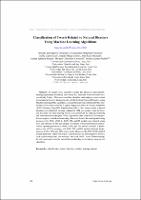Classification of Tweets Related to Natural Disasters Using Machine Learning Algorithms
| dc.contributor.author | Iparraguirre-Villanueva, Orlando | |
| dc.contributor.author | Melgarejo-Graciano, Melquiades | |
| dc.contributor.author | Castro-Leon, Gloria | |
| dc.contributor.author | Olaya-Cotera, Sandro | |
| dc.contributor.author | John, Ruiz-Alvarado | |
| dc.contributor.author | Epifanía-Huerta, Andrés | |
| dc.contributor.author | Cabanillas-Carbonell, Michael | |
| dc.contributor.author | Zapata-Paulini, Joselyn | |
| dc.date.accessioned | 2023-12-20T15:11:40Z | |
| dc.date.available | 2023-12-20T15:11:40Z | |
| dc.date.issued | 2023 | |
| dc.identifier.uri | https://hdl.handle.net/20.500.13067/2875 | |
| dc.description.abstract | Abstract—In recent years, computer science has advanced exponentially, helping significantly to identify and classify text extracted from social networks, specifically Twitter. This work identifies, classifies, and analyzes tweets related to real natural disasters through tweets with the hashtag #Nat-uralDisasters, using Machine learning (ML) algorithms, such as Bernoulli Naive Bayes (BNB), Multinomial Naive Bayes (MNB), Logistic Regression (LR), K-Nearest Neighbors (KNN), Decision Tree (DT), Random Forest (RF). First, tweets related to natural disasters were identified, creating a dataset of 122k geo-located tweets for training. Secondly, the data-cleaning process was carried out by applying stemming and lemmatization techniques. Third, exploratory data analysis (EDA) was performed to gain an initial understanding of the data. Fourth, the training and testing process of the BNB, MNB, L, KNN, DT, and RF models was initiated, using tools and libraries for this type of task. The results of the trained models demonstrated optimal performance: BNB, MNB, and LR models achieved a perfor mance rate of 87% accuracy; and KNN, DT, and RF models achieved perfor mances of 82%, 75%, and 86%, respectively. However, the BNB, MNB, and LR models performed better with respect to performance on their respective metrics, such as processing time, test accuracy, precision, and F1 score. Demonstrating, for this context and with the trained dataset that they are the best in terms of text classifiers. | es_PE |
| dc.format | application/pdf | es_PE |
| dc.language.iso | eng | es_PE |
| dc.publisher | International Journal of Interactive Mobile Technologies (iJIM) | es_PE |
| dc.rights | info:eu-repo/semantics/openAccess | es_PE |
| dc.rights.uri | https://creativecommons.org/licenses/by/4.0/ | es_PE |
| dc.subject | Classification | es_PE |
| dc.subject | Tweets | es_PE |
| dc.subject | Disasters | es_PE |
| dc.subject | Machine learning | es_PE |
| dc.subject | Natural | es_PE |
| dc.title | Classification of Tweets Related to Natural Disasters Using Machine Learning Algorithms | es_PE |
| dc.type | info:eu-repo/semantics/article | es_PE |
| dc.identifier.journal | International Journal of Interactive Mobile Technologies (iJIM) | es_PE |
| dc.identifier.doi | https://doi.org/10.3991/ijim.v17i14.39907 | |
| dc.subject.ocde | https://purl.org/pe-repo/ocde/ford#2.02.04 | es_PE |
| dc.relation.url | https://online-journals.org/index.php/i-jim/article/view/39907 | es_PE |
| dc.source.volume | 17 | es_PE |
| dc.source.issue | 14 | es_PE |
| dc.source.beginpage | 144 | es_PE |
| dc.source.endpage | 162 | es_PE |
Files in this item
This item appears in the following Collection(s)
-
Ingeniería de Sistemas [332]


